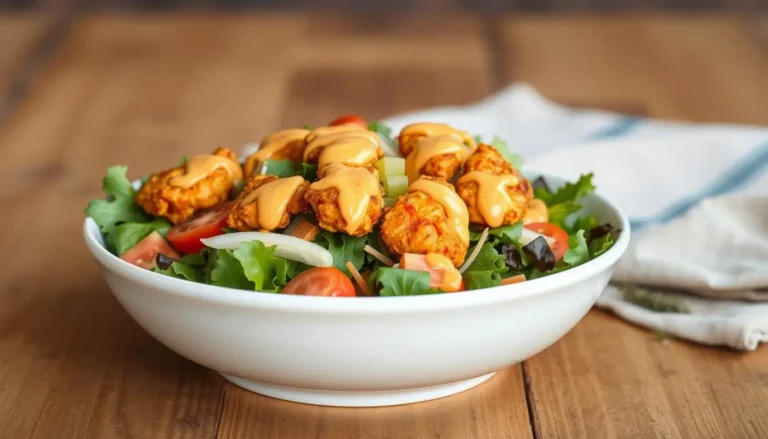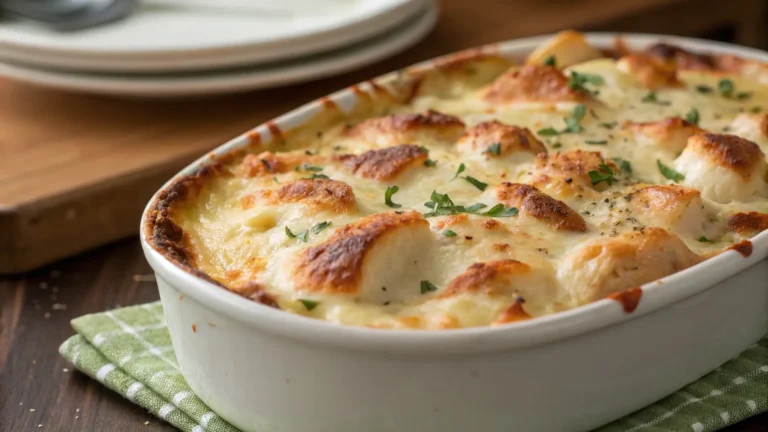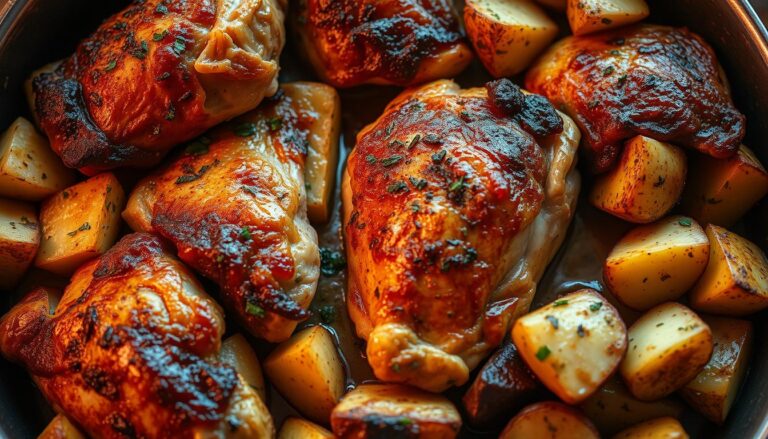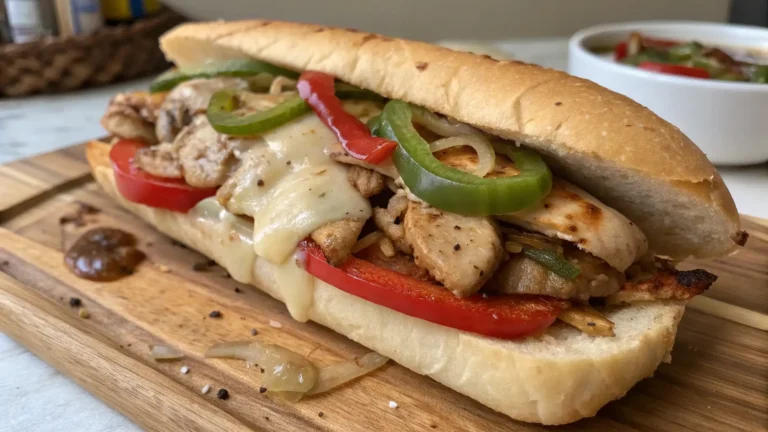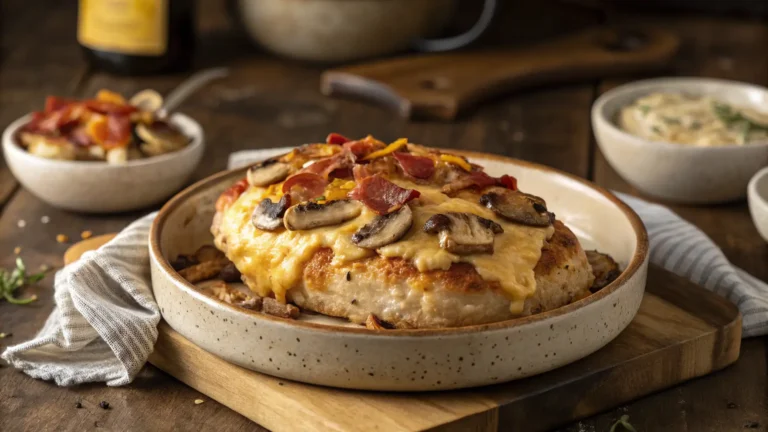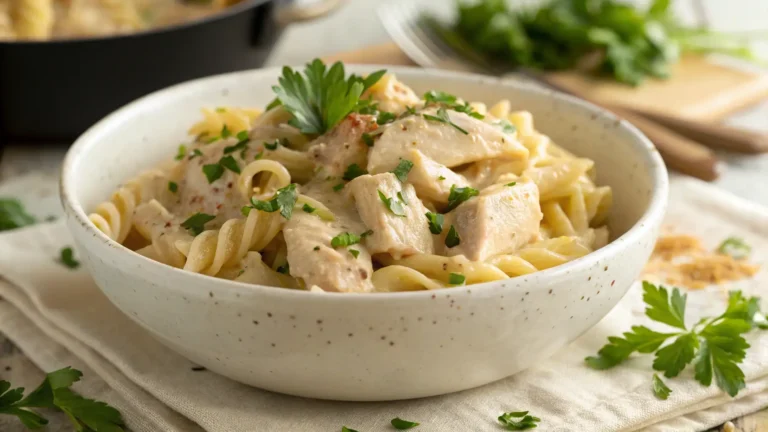Chicken Strips Recipe: How to Make Crispy, Juicy Homemade Chicken Tenders

Table of Contents
Crispy, golden, and mouthwateringly tender—that’s what makes a great chicken strips recipe so unforgettable. Whether you’re whipping up a quick weeknight dinner or hosting a weekend cookout, chicken strips deliver the perfect combo of comfort and crunch. This guide breaks down everything you need to know: ingredients, marinades, breading secrets, and tips for getting restaurant-quality results right from your own kitchen.
If you’ve struggled with soggy breading or dry meat, don’t worry. We’re diving deep into expert methods that guarantee juicy chicken strips with a perfectly crispy coating. You’ll also discover how to tweak the recipe for baking or air frying—without sacrificing flavor. Love experimenting with flavors? Don’t miss our Ultimate Wagyu Ground Beef Recipe Guide for equally crave-worthy meals.
Introduction to the Best Chicken Strips Recipe
Why Chicken Strips Are an All-American Favorite
Across the U.S., chicken strips are a go-to comfort food. From family dinners to food trucks, their crunchy coating and juicy inside win over just about everyone. But making them at home means you get to control every detail—from seasoning to fry temperature—so your chicken strips recipe turns out just the way you like it.
Homemade versions are also more adaptable. Pair them with mashed potatoes, toss them into wraps, or serve them over a crisp salad. They’re budget-friendly, kid-approved, and ideal for meal prepping.
Chicken Tenders vs Chicken Strips: What’s the Real Difference?
If you’ve ever wondered about the difference between chicken tenders and chicken strips, you’re not alone. Here’s the breakdown:
- Chicken tenders are an actual muscle, located under the chicken breast. They’re naturally more tender and often pricier.
- Chicken strips are slices of breast meat, making them leaner but still tender with the right prep.
While some purists distinguish between the two, most home cooks use both terms interchangeably—especially in a chicken strips recipe like this one, where proper marinating and breading can turn any cut into something spectacular.
Essential Ingredients for Chicken Strips
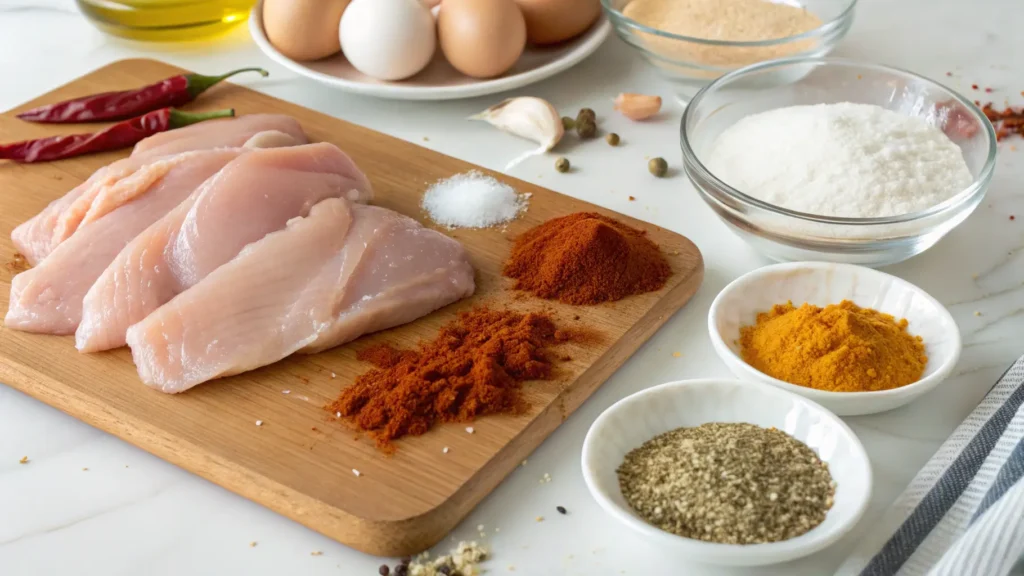
Must-Have Ingredients for Crispy Chicken Strips
No great chicken strips recipe starts without the right foundation—ingredients that help lock in moisture and build crunch. Here’s everything you’ll need:
| Ingredient | Purpose |
|---|---|
| Chicken breast or tenders | The base protein—tender, juicy meat |
| Buttermilk or yogurt | Tenderizes meat and adds tanginess |
| Eggs | Helps coating bind to chicken |
| All-purpose flour | Creates a dry base layer |
| Breadcrumbs or panko | Adds that irresistible crunch |
| Cornstarch | Lightens the flour for crispier texture |
| Salt & pepper | Core flavoring |
| Paprika | Adds color and mild heat |
| Garlic powder & onion powder | Boosts savory flavor |
| Cayenne (optional) | For those who like a little heat |
Using fresh chicken breast or real tenders ensures the meat stays juicy and flavorful. Pounding them to even thickness helps them cook evenly and avoids dry ends.
Many cooks use buttermilk as the marinating liquid, and for good reason—it contains lactic acid, which gently breaks down proteins and tenderizes without making the chicken mushy. If you don’t have buttermilk, plain Greek yogurt or even sour cream diluted with milk makes a solid backup.
Looking for inspiration? Try our flavor-rich meat ideas in this Best Venison Steak Recipes article.
The Best Seasonings to Enhance Chicken Flavor
Seasoning is where your chicken strips recipe gets its personality. While salt and pepper are must-haves, going beyond the basics creates a more layered flavor profile. Here’s what works especially well:
- Smoked paprika for a rich BBQ-like undertone
- Italian seasoning for a herbaceous twist
- Lemon zest or lemon pepper to brighten things up
- Curry powder if you want a fusion-style flavor
- Hot sauce mixed into your marinade for a fiery kick
Don’t just season the flour—season every step! That means seasoning your marinade, flour mixture, and even the breadcrumbs. This layered approach keeps every bite flavorful.
And if you’re wondering what seasoning to use for fried chicken in general, don’t be shy with spices. Garlic powder, cayenne, and onion powder bring savory heat that elevates basic strips into restaurant-quality bites.
For more inspiration on seasoning techniques, check out our savory breakdown in the Best Smoked Fish Brine Recipe.
Marinating Chicken for Maximum Tenderness
What Is the Best Thing to Marinate Chicken Tenders In?
If you’re aiming for juicy, flavorful chicken, skipping the marinade is not an option. A proper marinade doesn’t just add flavor—it breaks down tough muscle fibers to give you tender, melt-in-your-mouth chicken.
The best marinades for a chicken strips recipe typically include these components:
| Marinade Base | Why It Works |
|---|---|
| Buttermilk | Lactic acid tenderizes without making meat mushy |
| Yogurt | Similar to buttermilk, great for tang and tenderness |
| Pickle juice | The vinegar and salt tenderize and flavor |
| Lemon juice & olive oil | Classic acidic and fat combo |
| Hot sauce & milk | Adds spice and keeps the coating flavorful |
Buttermilk is hands-down the top choice. Its enzymes break down protein gently, and it helps the breading adhere better during coating. Let the chicken strips soak in the marinade for at least 30 minutes, though 4 to 12 hours is ideal for full flavor penetration.
You can also stir in spices like garlic powder, paprika, and cayenne directly into the marinade for double the flavor.
How Long Should You Marinate Chicken for Best Results?
The ideal marination time depends on your base:
- Buttermilk or yogurt: 4 to 12 hours
- Acidic marinades (lemon juice, vinegar): 1 to 2 hours (avoid over-marinating to prevent mushy texture)
- Store-bought marinades: Follow label instructions, but usually 30 mins to 2 hours
Never marinate chicken at room temperature for more than 30 minutes. Always cover it and place it in the refrigerator to prevent bacterial growth.
Pro tip: After marinating, remove the chicken from the liquid and let the excess drip off before breading. This helps avoid soggy breading and keeps your chicken strips recipe extra crispy.
Prepping the Chicken for Breading
Cutting and Cleaning Chicken Properly
Before you start coating, proper prep is essential for a successful chicken strips recipe. Whether you’re using breast meat or actual tenders, trimming and slicing the chicken into uniform strips helps ensure even cooking and consistent texture.
Here’s how to prep your chicken like a pro:
- Trim the fat: Use a sharp knife to remove any excess fat or connective tissue.
- Slice evenly: Cut chicken into ¾-inch wide strips to cook through evenly without drying out.
- Pat dry: After rinsing, pat each strip dry with a paper towel. This prevents steam from ruining your crisp breading.
- Optional step: Lightly pound the chicken between plastic wrap to ensure uniform thickness.
Cleanliness is key too. Always sanitize your cutting board, knife, and hands after handling raw chicken. And remember—never reuse marinade or tools without washing first.
This early attention to detail is what separates an average attempt from a truly standout chicken strips recipe.
The Secret to Juicy and Tender Chicken Every Time
Achieving a juicy center starts way before the frying pan. Aside from marinating (covered in Part 3), there are a few additional techniques to lock in moisture:
- Don’t skip the rest time: After breading, let your chicken strips rest for 10–15 minutes before cooking. This helps the coating bind and keeps moisture sealed in.
- Avoid overcooking: Whether frying or baking, chicken strips are done when the internal temperature reaches 165°F. Overcooking dries out the meat.
- Use a light hand when coating: Pressing too hard compacts the coating and can squeeze out moisture.
One underrated trick? Double-dipping. That’s right—dip your chicken in flour, then egg, then back in flour or breadcrumbs again. This creates a thicker barrier that keeps juices in and makes your chicken strips recipe extra crispy.
If you’re going the oven or air fryer route, consider spraying or brushing a little oil on the surface to get that golden-brown crust without frying.
Coating Techniques for Crispy Chicken Strips
Do You Add Milk to Eggs When Breading Chicken?
This question comes up often—and yes, many cooks swear by adding a splash of milk to beaten eggs. Why? It thins the egg mixture slightly, allowing for smoother coating coverage and better adherence between flour and breadcrumbs.
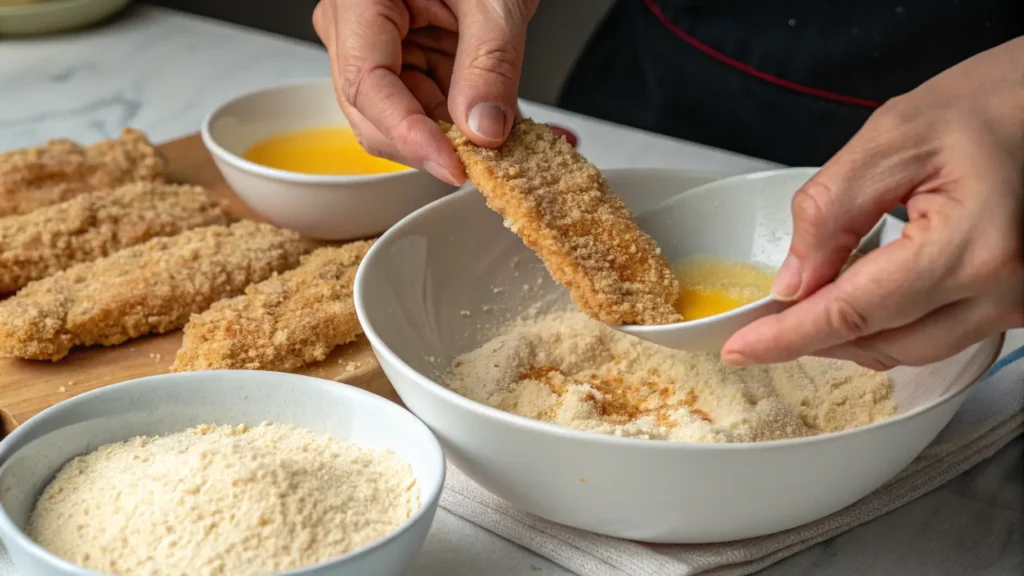
Here’s a simple coating setup you can follow for your chicken strips recipe:
| Bowl | Ingredients | Purpose |
|---|---|---|
| 1 | Seasoned flour | First dry layer to help egg stick |
| 2 | Eggs + 1 tbsp milk | Binder to attach crumbs |
| 3 | Panko or breadcrumbs | Final coating for crunch |
Use 1 tablespoon of milk per 2 eggs. Whisk until combined. Dip the chicken into the flour first, then egg-milk mix, and finally into breadcrumbs or panko. Press gently so the coating adheres well, but don’t overdo it or you’ll knock off the layers.
Adding milk also helps prevent the egg mixture from becoming too thick and sticky—especially useful when preparing several batches in a row.
How to Coat Chicken With Egg and Flour the Right Way
There’s a reason some chicken turns out perfectly crispy, while others have flaky or patchy coating. Here’s how to coat like a pro:
- Start dry: Make sure your chicken is fully patted dry before coating. Moisture ruins crispness.
- First dredge: Dip into seasoned flour to create a dry base. This lets the egg mix stick better.
- Egg wash: Coat evenly in the egg-milk mixture. Let excess drip off.
- Final coat: Press gently into breadcrumbs or panko. Flip and repeat.
Bonus Tip: Let coated strips rest on a wire rack for 10–15 minutes before frying or baking. This “sets” the coating and helps it stick better during cooking.
Double-coating can also be a game changer. For extra crunch in your chicken strips recipe, try this order:
Flour → Egg → Flour → Egg → Breadcrumbs
It adds an extra crispy layer while keeping the inside juicy.
Still having issues with the breading slipping off? That’s coming up next in Part 6, but here’s a sneak tip: don’t overcrowd the pan—doing so steams the chicken and weakens the coating.
Cooking Methods — Frying, Baking, and Air Frying
How to Fry Chicken Strips Without Drying Them Out
Frying is the classic method that gives your chicken strips recipe that golden crunch we all crave. But there’s a fine line between crispy and overcooked. The secret? Keep your oil hot but not scorching—350°F (175°C) is the sweet spot.
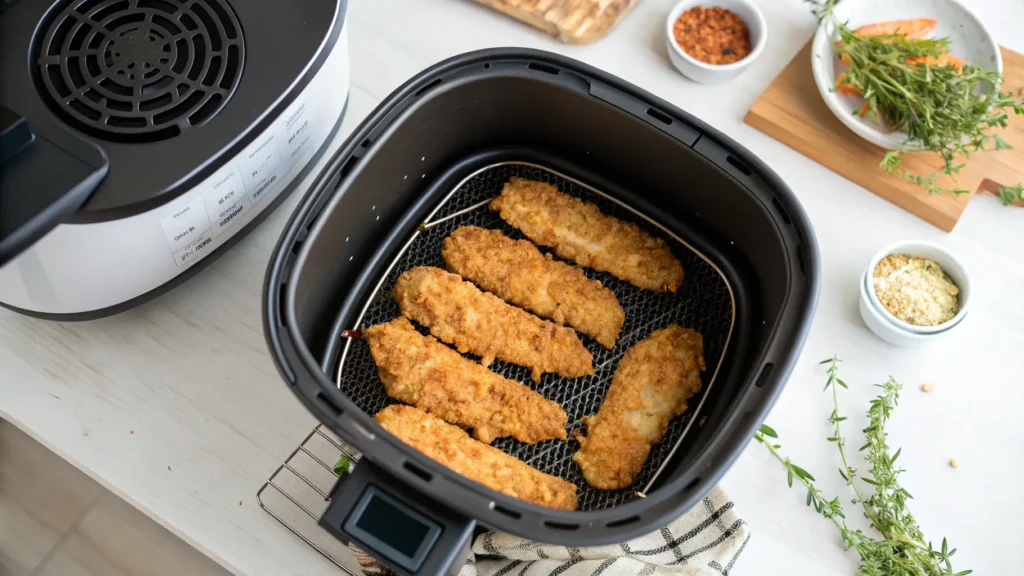
Here’s how to do it right:
- Use a deep skillet or Dutch oven with at least 2 inches of oil.
- Work in batches. Overcrowding lowers the oil temp and leads to soggy strips.
- Fry for 4–6 minutes or until golden brown and the internal temp hits 165°F.
- Drain on a wire rack, not paper towels, to avoid sogginess.
A well-fried chicken strips recipe delivers an irresistible contrast—crispy on the outside, juicy on the inside. Don’t forget to let your coated strips rest before frying. This helps the breading stay on during the cook.
If you’re worried about grease or calories, don’t worry—your chicken strips recipe can still shine using other methods.
Healthier Alternatives: Baked and Air-Fried Chicken Tenders
For those looking to lighten things up, baking or air frying offers a cleaner twist on this classic dish.
Baking Instructions:
- Preheat oven to 425°F (220°C)
- Place coated chicken strips on a parchment-lined baking tray
- Spray lightly with oil for even browning
- Bake for 18–22 minutes, flipping halfway
Air Frying Instructions:
- Preheat air fryer to 400°F
- Arrange strips in a single layer (don’t overcrowd)
- Spray with oil and cook for 10–12 minutes, flipping once
Both methods reduce oil content but still produce amazing crunch. With a few small tweaks, your chicken strips recipe can go from deep-fried indulgence to weeknight healthy favorite—without sacrificing flavor.
No matter which cooking method you choose, these techniques ensure your chicken strips recipe turns out crispy, juicy, and satisfying every time.
Expert Tips for Getting Breading to Stick
Why Your Breading Falls Off—and How to Fix It
Few things ruin a good chicken strips recipe faster than breading that falls apart mid-cook. If you’ve ended up with patchy, soggy coating or bare chicken, you’re not alone—it’s one of the most common mistakes.
Here are the likely culprits:
- Too much moisture on the chicken before dredging
- Skipping the rest time after coating
- Not pressing the coating in firmly enough
- Overcrowding the pan or turning the chicken too early
To fix it: Always start with dry chicken. After the egg and breadcrumb dip, gently press the coating into the strips so it forms a solid crust. Then let your breaded chicken strips rest on a wire rack for 10–15 minutes before cooking. This resting period is crucial—it allows the layers to bind and helps everything stay put.
Using these small tweaks makes a huge difference in the final texture of your chicken strips recipe.
Pro Techniques for Even, Crunchy Coating
Want that picture-perfect golden finish? Use these pro-level techniques:
- Double dredge: Flour → Egg → Flour again → Egg → Breadcrumbs
- Chill before cooking: Pop your breaded chicken in the fridge for 20 minutes to set the coating
- Use panko mixed with crushed cornflakes for extra crunch
- Spray oil evenly if baking or air frying—no dry spots means better browning
These steps guarantee that every bite of your chicken strips recipe will have that satisfying, shatteringly crisp texture. Breading that clings and crunches—exactly what great homemade strips are all about.
Dipping Sauces and Serving Ideas
Top 5 Homemade Dipping Sauces That Pair Perfectly
No chicken strips recipe is complete without something irresistible to dunk into. While ketchup and ranch are staples, homemade sauces can elevate your dish from fast food to gourmet. Here are five flavor-packed favorites:
| Sauce | Key Ingredients |
|---|---|
| Honey Mustard | Dijon, honey, mayo, lemon juice |
| Garlic Aioli | Mayo, minced garlic, lemon, salt |
| Buffalo Ranch | Hot sauce, ranch, melted butter |
| Sweet Chili Sauce | Rice vinegar, sugar, red chili flakes |
| BBQ Chipotle | BBQ sauce, adobo sauce, smoked paprika |
These sauces bring bold, tangy, spicy, and creamy notes that perfectly contrast the crispy coating in your chicken strips recipe. For a fun serving twist, try offering 2–3 sauces on a tasting board with fresh veggie sticks or waffle fries.
Side Dishes to Serve With Chicken Strips
Pairing your strips with the right sides makes your meal more filling and balanced. Here are some great options that complement any chicken strips recipe:
- Coleslaw: Crisp and tangy to cut through fried richness
- Mac & Cheese: The ultimate comfort pairing
- Cornbread or biscuits: Adds a Southern-style twist
- Roasted veggies or fries: For a hearty, crispy crunch
- Pickles or slaw on the side: For texture and acidity
You can also turn your chicken into a meal hero by using it in wraps, sliders, or chopped into a salad for texture and protein.
With great sides and flavorful dips, your chicken strips recipe becomes a restaurant-worthy meal that’s perfect for weeknights, weekends, or gatherings.
Storing and Reheating Chicken Strips
How to Store Leftover Chicken Strips Without Losing Crunch
If you’ve followed this chicken strips recipe closely, chances are you’ll want leftovers to taste just as crispy and juicy the next day. The key? Store them properly.
First, let your chicken strips cool completely on a wire rack—never seal them while hot or the steam will make them soggy. Then:
- Place strips in an airtight container lined with a paper towel
- Store in the refrigerator for up to 3–4 days
- For freezing, use freezer-safe bags and separate layers with parchment paper
Avoid stacking strips directly on top of one another to prevent crushing the crisp coating.
Best Reheating Methods to Keep Them Juicy
The microwave may be fast, but it kills crunch. For best results when reheating your chicken strips recipe, try these:
- Oven Method (best for large batches)
- Preheat oven to 375°F
- Place strips on a wire rack over a baking sheet
- Heat for 10–12 minutes until hot and crispy
- Air Fryer Method
- Preheat to 350°F
- Cook for 4–6 minutes, flipping halfway through
Both methods re-crisp the coating while keeping the inside juicy. Avoid pan-frying again—this can overcook the meat and make the coating too greasy.
If your chicken strips recipe ends up being a favorite in your house, mastering the storage and reheating process is a must. It guarantees you can enjoy leftovers that taste freshly made every time.
Conclusion: Mastering the Ultimate Chicken Strips Recipe
When it comes to comfort food, nothing beats a golden, juicy chicken strips recipe made from scratch. From choosing the right ingredients to marinating for tenderness, getting the breading to stick, and using the right cooking method—each step plays a crucial role in delivering that perfect crunch and flavor.
Whether you prefer deep-fried indulgence or a healthier air-fried version, this guide arms you with everything you need to master your own chicken strips recipe at home. Plus, with smart storage and reheating techniques, leftovers never have to be soggy again.
Craving more comfort food ideas? Don’t miss our Ultimate Wagyu Ground Beef Recipe Guide, or discover something new in Best Venison Steak Recipes and Best Smoked Fish Brine Recipe.
Now go on, grab your favorite dipping sauce and show that skillet who’s boss.
FAQs About Chicken Strips Recipe
What ingredients do you need to make chicken strips?
To make a flavorful chicken strips recipe, you’ll need chicken breast or tenders, flour, eggs, breadcrumbs or panko, buttermilk (or yogurt), and a blend of spices like garlic powder, paprika, salt, and pepper. Optional extras like cayenne or Italian seasoning can enhance the flavor even more.
What is the best thing to marinate chicken tenders in?
The best marinade for chicken tenders is buttermilk, thanks to its lactic acid content, which tenderizes the meat while adding rich flavor. Other great options include Greek yogurt, pickle juice, or a lemon juice–olive oil combo—each working well with your chicken strips recipe.
How do you get breading to stick to chicken strips?
To get breading to stick perfectly, follow the standard flour → egg → breadcrumb method, and make sure the chicken is dry before starting. Letting your coated chicken rest for 10–15 minutes before cooking also helps prevent the breading from falling off during frying or baking.
What is the difference between chicken tenders and chicken strips?
Chicken tenders are a specific cut of meat—the pectoralis minor—located just below the breast. Chicken strips are simply sliced pieces of breast meat. Both can be used in a chicken strips recipe, though tenders are often more naturally tender.
What is the best liquid to tenderize chicken?
Buttermilk is the top choice for tenderizing chicken, especially in fried or baked dishes. It breaks down proteins gently, making it ideal for any juicy chicken strips recipe. Lemon juice or yogurt also work but can be stronger in flavor.
What is the secret to juicy tender chicken?
The secret lies in marinating, using even cuts, and not overcooking. Always use a meat thermometer and pull the chicken out at 165°F internal temperature. Also, allow your chicken to rest before and after cooking to retain its juices.
Do you add milk to eggs when breading chicken?
Yes, adding a tablespoon of milk to beaten eggs makes the egg wash thinner and more spreadable, helping your coating stick better. It’s a useful trick in any successful chicken strips recipe.
What seasoning should I put on fried chicken?
Use salt, black pepper, garlic powder, paprika, and onion powder for a base. For more flavor, try adding cayenne pepper, Italian seasoning, or smoked paprika. Always season both your flour and breadcrumbs for maximum taste.
How to coat chicken with egg and flour?
Start by dredging dry chicken in seasoned flour, then dip it into an egg wash (eggs + milk), and finish with breadcrumbs or panko. Press the coating in lightly and let it rest before cooking for a flawless crispy crust.
What is the fancy name for chicken tenders?
The culinary term for chicken tenders is “chicken goujons.” In upscale menus, you might also see them referred to as chicken fillets or chicken fingers, but it’s the same tender cut used in your go-to chicken strips recipe.
Have you given our recipe a try?
There are no reviews yet. Be the first one to write one.

